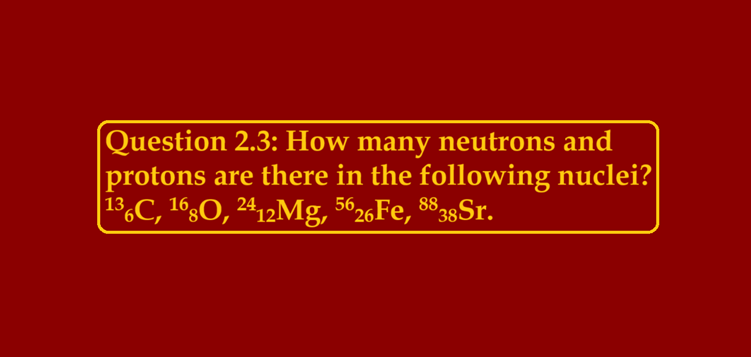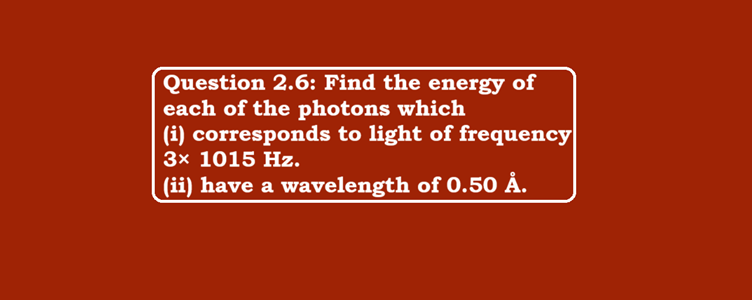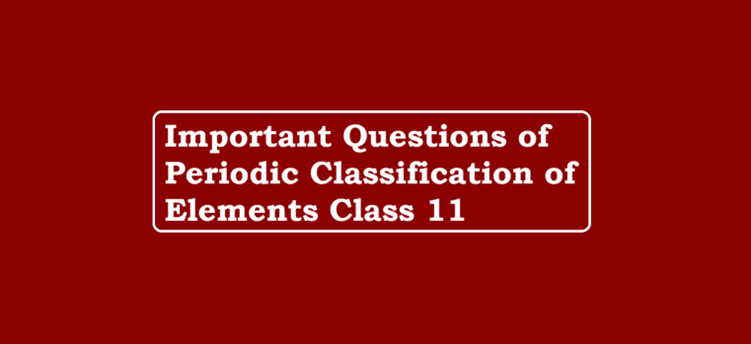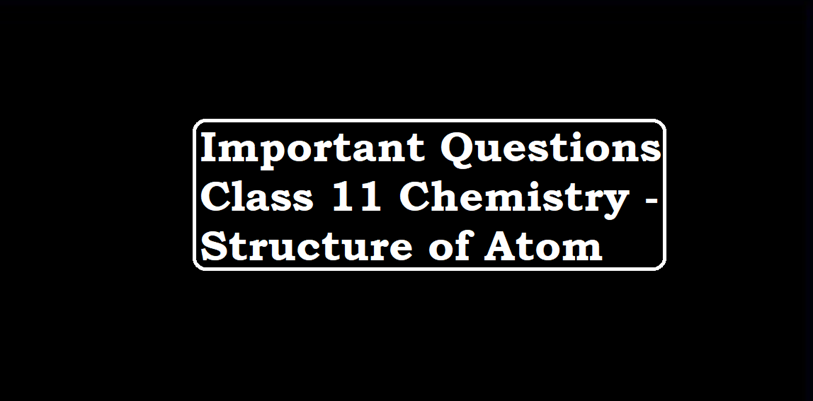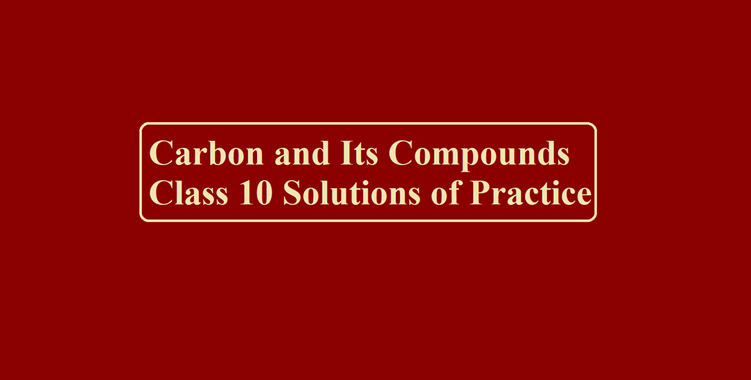https://www.youtube.com/watch?v=6-di0ujG_Ew Question 2.3: How many neutrons and protons are there in the following nuclei? 136C, 168O, 2412Mg, 5626Fe, 8838Sr Ans 2.3: 136C Atomic mass = 13 Atomic number = Number of protons = 6 Number of neutrons = Atomic Mass – Atomic Number ∴ Number of neutrons = 13 – 6 = 7 168O Atomic mass = 16 Atomic number = 8 Number of protons = 8 Number of neutrons = Atomic Mass – Atomic Number ∴ Number of neutrons = 16 – 8 = 8 2412Mg Atomic mass = 24 Atomic number = Number of protons = 12…
Author: Dr. Vikas Jasrotia
Question 2.5: Yellow light emitted from a sodium lamp Question 2.5: Yellow light emitted from a sodium lamp has a wavelength (λ) of 580 nm. Calculate the frequency (ν) and wave number (v¯) of the yellow light. Ans 2.5: We know λ = c/ ν c = velocity of light (3 × 108 m/s) λ = Wavelength = 580 nm = 580 × 10-9 m ν = c/ λ ν = 3 × 108 / 580 × 10-9 ν = 5.17 × 1014 s-1 Thus, the frequency of yellow light emitted from the sodium lamp = 5.17 × 1014 s–1…
Question 2.6: Find the energy of each of the photons Question 2.6: Find the energy of each of the photons which (i) corresponds to light of frequency 3× 1015 Hz. (ii) have a wavelength of 0.50 Å. Ans 2.6. We know (i) Energy (E) of a photon (E) = hν —————–A Where, h = Planck’s constant = 6.626 × 10–34 Js ν = frequency of light = 3 × 1015 Hz ν = 3 × 1015 s–1 Substituting the values of h and ν in expression A E = (6.626 × 10–34) (3 × 1015) E = 1.988 × 10–18…
Important Questions of Periodic Classification of Elements Class 11 Important Questions of Periodic Classification of Elements Class 11 Que 1. An element is present in the third period of the p-block. It has 5 electrons in its outermost shell. Predict its group. How many unpaired electrons does it have? Ans 1. It belongs to the 15th group (P). It has 3 unpaired electrons. Que 2. An element X with Z = 112 has been recently discovered. Predict its electronic configuration and suggest the group in which it is present. Ans 2. [Rn] 5f14 6d10 7s2. It belongs to the 12th…
Important Questions Class 11 Chemistry – Structure of Atom Important Questions Class 11 Chemistry Que 1. Calculate the charge of one mole of electrons. Ans 1. One electron has charge 1.602 × 10−19 coulombs one mole of electrons has charge = 6.023 × 1023 × 1.602 × 10−19 = 9.648846 × 104 = 96488.5 coulombs Que 2. Calculate the mass of one mole of electrons. Ans 2. Mass of electron = 9.1 × 10−31 kg One mole of electrons has mass = 6.023 × 1023 × 9.1 × 10−31 = 54.8 × 10−8 = 5.48 × 10−7 kg Que 3.…
Chapter 2 Science Class 9 – Questions and Answers Chapter 2 Science Class 9 Very Short Questions Que 1. Define solvent. Ans 1. The component of the solution that dissolves the other component in it is called the solvent. Que 2. Define solute. Ans 2. The component of the solution that is dissolved in the solvent is called the solute. Que 3. What is a ‘tincture of iodine’? Ans 3. A solution of iodine in alcohol is known as a tincture of iodine. It has iodine (solid) as the solute and alcohol (liquid) as the solvent. Que 4. What are…
Is Matter Around Us Pure MCQ With Answers Multiple Choice Questions: Que 1. What is the name of the metal which exists in the liquid state at room temperature? (a) Sodium (b) Potassium (c) Mercury (d) Bromine Que 2. When the liquid is spun rapidly, the denser particles are forced to the bottom and the lighter particles stay at the top. This principle is used in: (a) Centrifugation (b) Fractional distillation (c) Evaporation (d) Tunneling Que 3. Sol and gel are examples of —————— …
Periodic Classification of Elements Questions PDF (Answers) Periodic Classification of Elements Questions PDF Ans 1. NaOH > Mg(OH)2 > Al(OH)3. Because the basic strength decreases in a period on moving from left to right. Ans 2. 2, 8, 6 is the electronic configuration of the element with atomic number 16. It has 6 valence electrons. It belongs to the 16th group and the 3rd period. Ans 3. (i) Na, Si, and Cl have different properties, therefore they do not form Dobereiner’s triads even though the atomic mass of the middle atom Si (At. Mass – 28) is approximately the average…
Periodic Classification of Elements Questions Periodic Classification of Elements Questions Que 1. What is the correct order of relative basic character of NaOH, Mg(OH)2, and Al(OH)3? Que 2. An element has the atomic number 16. To which group and period does it belong? Que 3. Can the following groups of elements be classified as Dobereiner’s triad? i) Na, Si, Cl ii) Be, Mg, Ca Atomic mass of Be – 9, Na – 23, Mg – 24, Si – 28, Cl – 35, Ca – 40. Give justification for your Answer. Que 4. What was the basis of the classification of elements…
Carbon and Its Compounds Class 10 Solutions of Practice Questions Carbon and Its Compounds Class 10 Solutions Ans 1. (i) CH3Cl Chloromethane (ii) C2H5Cl Chloroethane Ans 2. Covalent compounds have low melting and boiling points due to small intermolecular forces of attraction between the atoms. Ans 3. (i) Alcohol group (ii) Carboxylic acid group Ans 4. Unsaturated hydrocarbons have more amount of carbon, therefore burn with smoky flame due to incomplete combustion. Ans 5. (i) Valency of each carbon atom in an alkane is four. (ii) Valency of each carbon atom in an alkyne is four. Ans 6. (i) Catenation…
